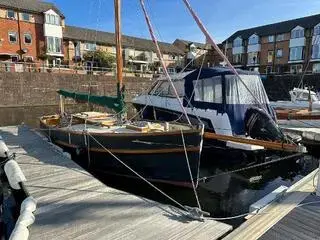
LENGTH:
29.27 ft.
|
YEAR:
1978
LOCATION:
Cardiff
OFFERED BY:
BJ Marine
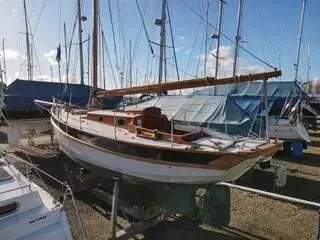
LENGTH:
29.99 ft.
|
YEAR:
1987
LOCATION:
Levington,
OFFERED BY:
CLARKE & CARTER YACHT BROKERS
LENGTH:
30.41 ft.
|
YEAR:
1989
LOCATION:
Argyll and Bute
OFFERED BY:
Mark Cameron Yachts
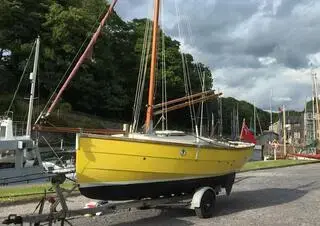
LENGTH:
19.26 ft.
|
YEAR:
1989
LOCATION:
Bangor, Gwynedd,
OFFERED BY:
Dickies of Bangor
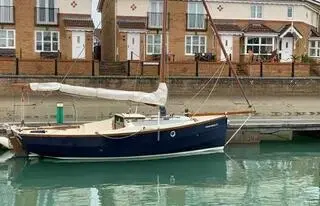
LENGTH:
19.0 ft.
|
YEAR:
1993
LOCATION:
East Cowes
OFFERED BY:
Boatpoint
LENGTH:
35.5 ft.
|
YEAR:
1995
LOCATION:
Plymouth
OFFERED BY:
The Barbican Yacht Agency
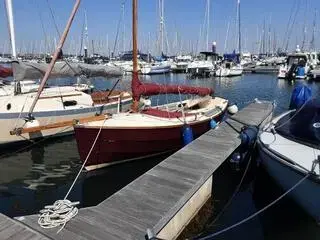
LENGTH:
20.01 ft.
|
YEAR:
1998
LOCATION:
Portland
OFFERED BY:
Boatpoint
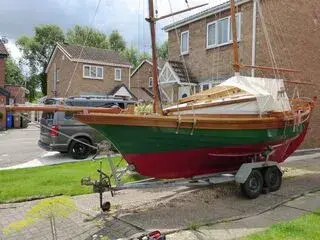
LENGTH:
21.16 ft.
|
YEAR:
1999
LOCATION:
East Yorkshire
OFFERED BY:
Boatshed
Boat not available.
LOCATION
Plymouth United Kingdom
YEAR
1979
LENGTH
29.99 ft.
Condition
Used
Name
'Black Goose'
Year
1979
Make & Model
Cornish-Crabbers Trader 30
Boat type
Sail
Length
29.99 ft.
Fuel Type
Diesel
Location
Plymouth United Kingdom
Tax status
Paid
Beam
9.51 ft.
Draft Max
5.25 ft.
LWL
25.75 ft.
Cornish Crabbers' Trader 30. A 'Ready to go' package representing good value at £56,950.
For those 'in the know', the Cornish Crabbers Trader 30 - with her higher deck level and the resultant greater internal headroom, combined with ketch rig's long, low sail plan and lower centre of effort, is the one to look for (as opposed to the cutter version) - despite there having been fewer 'Traders' built. 'Black Goose' is an early example - hull No.4 of eleven built - dating from around 1980/81, but has been steadily upgraded over recent years, with much good work done and money spent - particularly since 2014.
The Trader 30 features a divided cockpit with tandem wheels mounted on the same bridge deck as the mizzen mast's step ensuring that she may be hand-sailed from the main [almost midships] cockpit, or the dedicated helming cockpit, abaft the mizzen mast. Aficionados love this feature!
'Black Goose' benefits from a replacement 29HP Beta Marine engine and associated sterngear all newly fitted in 2014, that replaced a smaller original engine. She has been epoxy coated beneath the waterline for decades now and was last cleaned back and re-coated, using seven coats of Hempel's in 2019. The spars have been stripped, epoxy coated and then varnished & painted. Standing and running rigging replaced 2014, with a conventional roller-furling system by Facnor fitted to the outer for'stay in 2020 in place of the Wicor Martin-style original fittings to make for a reliable and more convenient system, combining with a slightly larger flying jib. The owner reports that directional balance is enhanced and the vessel made more convenient to handle by [in effect] himself, when sailing shorthanded.
In current ownership, much very good quality and detailed work has been carried out by the owner himself, including the replacement of a diesel-fired space heater with a Canadian wood-fired stove and insulated flue, replacement cooker and associated gas system throughout, re-veneered sole boards, tasteful re-painting of the internal bulkheads and fascias, LED lighting throughout, etc. etc.
Currently laid ashore, with a scheduled launch date of end of March 2022, 'Black Goose' will be fully prepared and re-commissioned for the new owner and handed over on the water upon completion within the sale price.
For'cabin:two berths set in conventional 'vee', but with lift-out cushion able to flip over and provide a cosy 'double' (generous single) offset to port side. The cabin is lit with dancing light from the surrounding water's surface by two fixed hull ports. The original 'Houdini' hatch above has been replaced with a modern unit by Bainbridge. Access to chain locker at foot of the berths, with hull-side linings thought to be original in beige needlecord. This cabin may be fully closed from the heads compartment by means of a transverse-sliding door.
Heads Compartment: Running across the full beam of the hull abaft the forward cabin, this has been tastefully re-finished and fitted with a modern Jabsco marine-flushing toilet and freshly veneered teak and holly sole board. A stainless steel hand basin (with loose bowl to suit) and foot pumped cold water supply is fitted to starboard side, inboard of a storage unit featuring cave lockers and shelved closed locker, beneath the side deck. Natural ventilation is provided by overhead, 'Dorade'-style ventilators by Vetus.
Main Cabin/Saloon: The main bulkhead, to the forward end of this space features a dog-leg recess to accommodate a traditional-style of stove, with closed lockers to either side of the bulkhead, facing aft. The previous diesel-burning heater having been removed and replaced using a wood-burning stove from Canada and - importantly - an insulated flue fitted. Two single settee berths each side, with very natty hardwood leeboards run parallel to the centre-line, providing settee seating facing each other across a folding table that is hinged and mounted on an aft part bulkhead between the saloon area and the galley. This may be raised to leave the full sole area uncluttered when the table is not required. Officially [one might say] there is a quarter berth too, running beneath the starboard side deck, outboard of the main cockpit. Access is alongside the companionway down into the main cabin, but is 'tight' and for the most part, a fold-down chart working surface remains deployed pretty well 'full time' over the head of this berth. The volume above and beneath this 'berth' is used primarily for storage.
Galley: This is of U-shape, with comfortable half bulkhead against which to rest, fitted between port side main saloon seating and the galley itself. The original, drab painted finish of dark brown has been replaced with a tasteful pale blue and a fresh, white-coloured laminate fitted. A single stainless steel sink (with an additional loose bowl) has been strategically placed to enhance the amount of working space and features a draining board too, while the replacement cooker, with two burner hob, grill and oven was professionally fitted in 2019, together with its associated gas supply pipework and canister locker. The more economical Calor canisters (rather than Camping Gaz) can be accommodated and a bubble leak detector was fitted for additional safety. Light and ventilation in the galley has been ensured by an opening portlight (galley to cockpit) and then enhanced recently by the fitting of a new overhead hatch above, while artificial lighting has been uprated by the fitting of LED lights above the new worksurface and outboard of the cooker. The under work surface lockers that you see in the pictures are shelved rather being simply open spaces, with a gash bin neatly accommodated in one of them. The cave locker unit - outboard of the cooker and under the side deck - has been removed and painted out nicely. In short: a clean, comfortable galley suitable for use either under way or at moorings.
Rigged as a ketch on Spruce spars, both masts have been stripped, epoxied and then varnished. The standing rigging is of stainless steel 5x16 talurited wire (in place of galvanised mild steel) with stainless steel turnbuckles. The original Wickham Martin -style of furler for the flying jib has been replaced with a conventional modern Facnor furling system incorporating a single rotating drum and aluminium extrusions to ensure a reliable and convenient means of furling the headsail, while the stays'l is simply hanked on the inner for'stay.
The original boom is fitted with means of slab reefing the mainsail (2 X reefs) and both the main and the mizzen sails are protected by 'Stakpak' style of boom covers to assist in the handling of the canvas. They have proved invaluable in receiving and containing the gaffs as well as the sails themselves.
The sail wardrobe includes:
The Beta Marine 30 HP engine was fitted in 2014, together with a new propeller and shaft, waterlock etc. and replaced the original, 19hp raw seawater-cooled Yanmar 2GM20.
A flexibly mounted, water-fed 'dry' seal [stern gland] by PSP has also been fitted, with the current owner having replaced the hull-fitted tail housing in 2020 and a new 'Cutless' bearing fitted at same time - naturally.
Current engine running hours (Dec.2021) recorded as 310.4 hrs
Electrical Systems
2 lead acid batteries (1 x 85 A/hr plus 1 x 77A/hr) charged by the engine-driven alternator through a voltage sensing regulator.
A 240V AC (20 Amp output) battery charger is also fitted for use when the vessel is connected to shore support, with 13 Amp sockets provided in the main cabin and forward cabin too. A RCD 'trip' for safety is fitted at the chart working area/quarter berth.
Two, relatively recent six-way DC circuit breaker panels located at the chart working area protect and select the 12V DC systems - with the batteries themselves being isolated and selected by individual, modern switches (mounted conveniently to hand), behind the companionway steps.
Fuel tank:
Stainless steel tank, with max capacity approximately 90 litres located beneath port side deck and outboard of engine space. Tank removed and pressure washed clean 2014.
Freshwater:
Two polypropylene (PP), tanks (54 litres each), mounted to either side of the centreline, beneath the main cabin's settee berths. Fitted new in 2019, both with inspection hatches and individual shut-off/isolation valves.
The design features a steel, L-shaped centreplate that is pivoted just abaft the line of the mast and rising into the hull beneath the main cabin's sole to obviate any intrusion into the accommodation space. Operation is by 20:1 drum winch mounted alongside the companionway down from the main cockpit. The centreplate is reported to have been removed and re-finished in 2014, with the pivot pin and lifting strop wire replaced at same time.
A Beta Marine 30 HP engine (new) was fitted in 2014 and the hours running indicator currently records just 310.4 hrs. The engine was last fully serviced autumn 2020, with the sump oil and filter having been changed upon lay-up autumn 2021.
The current propeller dates from the engine replacement in 2014, together with the shaft and associated stern seal.
The underwater surfaces were stripped of antifouling in 2019 to expose the previous and underlying epoxy coatings (of unknown age). The surface was pressure cleaned and dried under a professional marine surveyor's recommendation; some isolated, minor blistering opened up, cleaned and fully dried before being individually filled before the whole of the underwater surfaces were coated with a further six coats of Hempels' underwater epoxy primer, one coat of primer; one coat of hard racing anti-fouling (white) and two coats of 'Sea Jet' self-ablating anti-fouling paint.
The galvanised shroud plates were removed in winter 2018/19 and replaced with stainless steel.
The vessel's standing and running rigging is reported to have been replaced in 2014.With a new roller-furling system by Facnor fitted to the outer for'stay by professional riggers for the 2020 season.
All main spars have been stripped, allowed to dry undercover, epoxied and then re-varnished (using Hempels' 'Classic' varnish) over winter 2019/2020.
Much of the original internal finishes have been tastefully replaced/re-painted, with fresh lining above and re-veneered sole boards below. Cushions coverings are of the original, buttoned green vinyl.
Engine Count
1
Engine Horse Power
30.0
Engine Hours
310
Propeller Type
3 Blade, Bronze
HULL
Ballast
2340.54
Hull Material
Fiberglass
OTHER
Length on Deck
9.14 meters
Displacement(kgs)
6096.28 kilograms
Drive Transmission Description
Direct
Drive Up
1.07 meters
Engine Year
2014
Engine Type
Inboard
No of Heads
1
Keel Type
Other
The Cornish-Crabbers Trader 30 is 30 feet long that boasts a 9.5 feet beam and a draft of 1.6 meters. This 1979 diesel Cornish-Crabbers Trader 30 powered by Beta 30 with 30.0 horsepower. The Cornish-Crabbers Trader 30 is made of fiberglass.